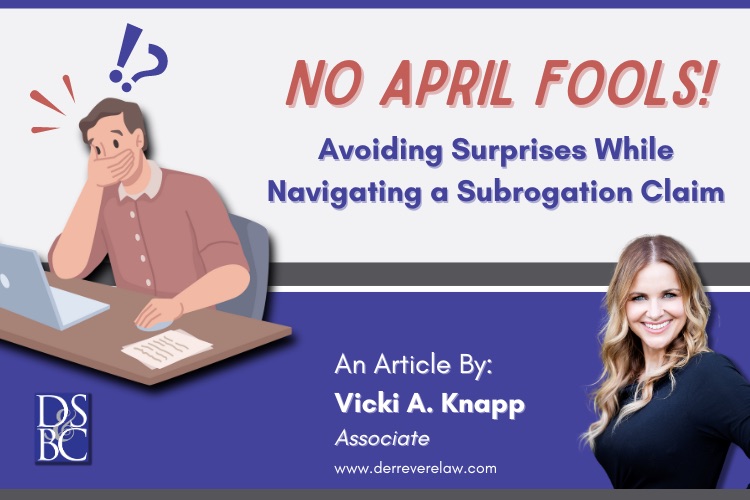No April Fools! Avoiding Surprises While Navigating a Subrogation Claim

April Fools’ Day has us all on the lookout for pranks, however it is never fun to be surprised when managing a subrogation claim. While there are endless pitfalls that could be waiting behind every door, there are some surprises for which you can be on the look-out. Here are a few potential issues to watch out for so that your new subrogation file is no laughing matter.
1. Surprise! There is a subrogation waiver.
You may have all the facts you need in your claim to prove negligence, but a great case complicated by a potential subrogation waiver, should not be left to be discovered and tripped over at the last minute. The first document to check is always the policy, which sometimes can contain waiver language. Other applicable contracts, such as bylaws, leases, sales orders, or even a target’s terms of service or warranties included with their products, could contain this wording.
2. Gotcha! The insured surprises you.
It is important to attempt to establish communication with the insured soon after you receive your claim so whatever assistance, or lack thereof, they provide, does not leave you blindsided. You may only need to obtain a few additional details, or alternatively you may require the insured’s more in-depth involvement, such as requesting their participation in a property inspection or needing them to sign a statement to support the claim. But, whatever the level of assistance, it is better to know if and how the insured will cooperate as early as possible. For instance, finding out from your insured that they do not wish to participate in future litigation is a revelation that could guide your claim management and that should not catch you unaware.
3.Watch Out! Stumbling through changing state laws.
The state law where your loss occurred can have major implications in how you manage your subrogation claim. For negligence claims, in particular, the insured’s level of liability could be the difference in your claim receiving a full, reduced or even zero recovery. You do not want to fall for believing you can recover from a carrier just because they admitted their insured was equally at-fault, only to discover too late that the loss occurred in a state that just adopted a 50% modified comparative negligence rule. For example, Florida recently switched to this from its former pure comparative negligence standard. Therefore, whereas before you could recover on a subrogation claim even if the insured was 99% liable, now your claim would be worthless if the insured is found to be more than 50% responsible. Keeping up to date with the applicable state law will ensure you do not end up feeling foolish.
4. Beware! The statute of limitations.
There could be no greater and unwanted surprise to a lawyer managing a subrogation claim than missing the deadline for your statute of limitations. As described above, ever-changing state laws require extra vigilance in monitoring your claim’s statutes. As an example, another aspect of Florida’s sweeping tort reform bill was the statute of limitations for negligence claims being reduced from 4 years to 2 years. Identifying early on what type of claim you have based on your facts can positively affect your strategy. For instance, product defect statutes can differ significantly in length from negligence statutes. So, if the question is whether the insured’s leaky refrigerator was due to faulty installation or a manufacturer’s defect, it is better to have the only possible surprise be that you have more time to file a lawsuit, rather than that time has elapsed.
5. A Surprise Party! Places in your claim where “the unexpected” may hide.
Out-of-pocket expenses: One surprise you may not have anticipated is that the insured has out-of-pocket expenses or that the carrier issued payments for which you were unaware. It is important to contact the client before you settle a claim to makes sure you have the complete and final adjusted amount of your claim;
Background checks: Performing a background check on your target, particularly before deciding whether to proceed with pursuit of the target, is essential to prevent looking foolish. Your target may have a lot of assets or may be penniless. They may have even passed away. Do not let this news come as a surprise to you after significant litigation expenses have already been incurred;
Missing potential adverse parties or carriers: There may be other targets to pursue than the initial adverse parties presented to you by the client. It is important to look behind every door to explore all avenues and exhaust your options in who you can pursue for the damages. Information on additional parties can be obtained from the insured or gathered from documents such as police reports, FOIA requests, underlying lawsuits, or even news reports related to the loss;
Releases: A release provided by a carrier might contain indemnity language or list unrelated, incomplete or inaccurate parties and claim information. Or it may include personal injury language when it is a property damage claim. Perhaps a party has already signed a release and you did not know about it. While there may always be an unknown component to your claim, performing your due diligence in evaluating the release language alongside conducting a thorough investigation, will aid in limiting the surprises.
Experts: Your expert may give you advice on the merit of your target’s theory of liability and can similarly guide you on how far you can take the claim. However, it is important to make sure that the expert upon which you are relying is qualified to testify in court on the matter. Additionally, if your expert, insured or even client failed to preserve the evidence for your claim, you could be surprised to find that your expert’s opinion may be rendered inadmissible.
Ultimately, your role as a subrogation professional will lead you to encounter endless pitfalls in April and throughout the year. However, staying alert to avoid some of these more common issues while navigating a new subrogation claim can help to prevent you from feeling foolish when surprises do pop up.




